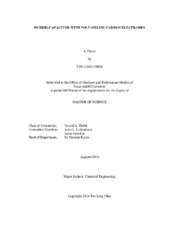| dc.contributor.advisor | Elabd, Yossef A. | |
| dc.creator | Chen, Tzu Ling | |
| dc.date.accessioned | 2016-09-22T19:42:41Z | |
| dc.date.available | 2018-08-01T05:57:45Z | |
| dc.date.created | 2016-08 | |
| dc.date.issued | 2016-07-27 | |
| dc.date.submitted | August 2016 | |
| dc.identifier.uri | https://hdl.handle.net/1969.1/157982 | |
| dc.description.abstract | Hybrid-capacitors have the potential to synergistically combine the benefits of both electrochemical double layer capacitors (EDLCs) (longer cycle life) and pseudo-capacitors (higher capacitance). However, new processes that intimately combine the two primary materials from each capacitor (carbon and conductive polymer, respectively) within the electrodes in an ordered fashion on the nanoscale are needed to realize this potential. In this study, we report on a physical method (simultaneous electro-spinning/electro-spraying (E/E)) and a chemical method (in situ oxidative polymerization) for fabricating hybrid-capacitors with high surface area electrodes consisting of polyaniline (PANI) and carbon materials (referred to as E/E electrodes).
E/E produces a PANI/carbon nanofiber/particle network with fiber diameters in the range of 500 to 2000 nm. The hybrid-capacitor with E/E electrodes exhibits an excellent specific capacitance of 235 F g^-1 (vs. 138 F g^-1 for capacitor with state-of-the art hybrid electrodes) at a current density of 1 A g^-1. Moreover, the capacitor with E/E electrodes retains approximately 84 % capacitance after 1000 charge-discharge cycles (vs. 67 % for capacitor with state-of-the art hybrid electrodes). A post mortem electron microscopy study of the E/E electrodes provides a rationale for the improved cycling stability. These results demonstrate the feasibility of producing E/E electrodes and their promise as future materials in hybrid-capacitors.
Multiwall carbon nanotube (MWCNT)/PANI composites synthesized via in situ oxidative polymerization show improved electrochemical performance in a capacitor compared with pure MWCNTs due to the compact chemical bonding between MWCNT and PANI. Hybrid-capacitors with E/E MWCNT-PANI composite electrodes were also investigated and showed improved performance. Capacitor performance has a high correlation with morphology and polymer-carbon interface and connectivity and can be modified by fabrication and synthetic processes. A deep fundamental understanding of charge storage mechanisms in hybrid materials will guide the design of future polymercarbon electrodes for hybrid-capacitors. | en |
| dc.format.mimetype | application/pdf | |
| dc.language.iso | en | |
| dc.subject | electrospinning | en |
| dc.subject | electrospraying | en |
| dc.subject | hybrid-capacitor | en |
| dc.subject | pseudo-capacitor | en |
| dc.subject | polyaniline | en |
| dc.title | Hybrid-Capacitor with Polyaniline/Carbon Electrodes | en |
| dc.type | Thesis | en |
| thesis.degree.department | Chemical Engineering | en |
| thesis.degree.discipline | Chemical Engineering | en |
| thesis.degree.grantor | Texas A & M University | en |
| thesis.degree.name | Master of Science | en |
| thesis.degree.level | Masters | en |
| dc.contributor.committeeMember | Lutkenhaus, Jodie L. | |
| dc.contributor.committeeMember | Grunlan, Jaime | |
| dc.type.material | text | en |
| dc.date.updated | 2016-09-22T19:42:47Z | |
| local.embargo.terms | 2018-08-01 | |
| local.etdauthor.orcid | 0000-0002-5035-5534 | |


